water pump TOYOTA MIRAI 2022 Owners Manual
[x] Cancel search | Manufacturer: TOYOTA, Model Year: 2022, Model line: MIRAI, Model: TOYOTA MIRAI 2022Pages: 556, PDF Size: 17.34 MB
Page 75 of 556
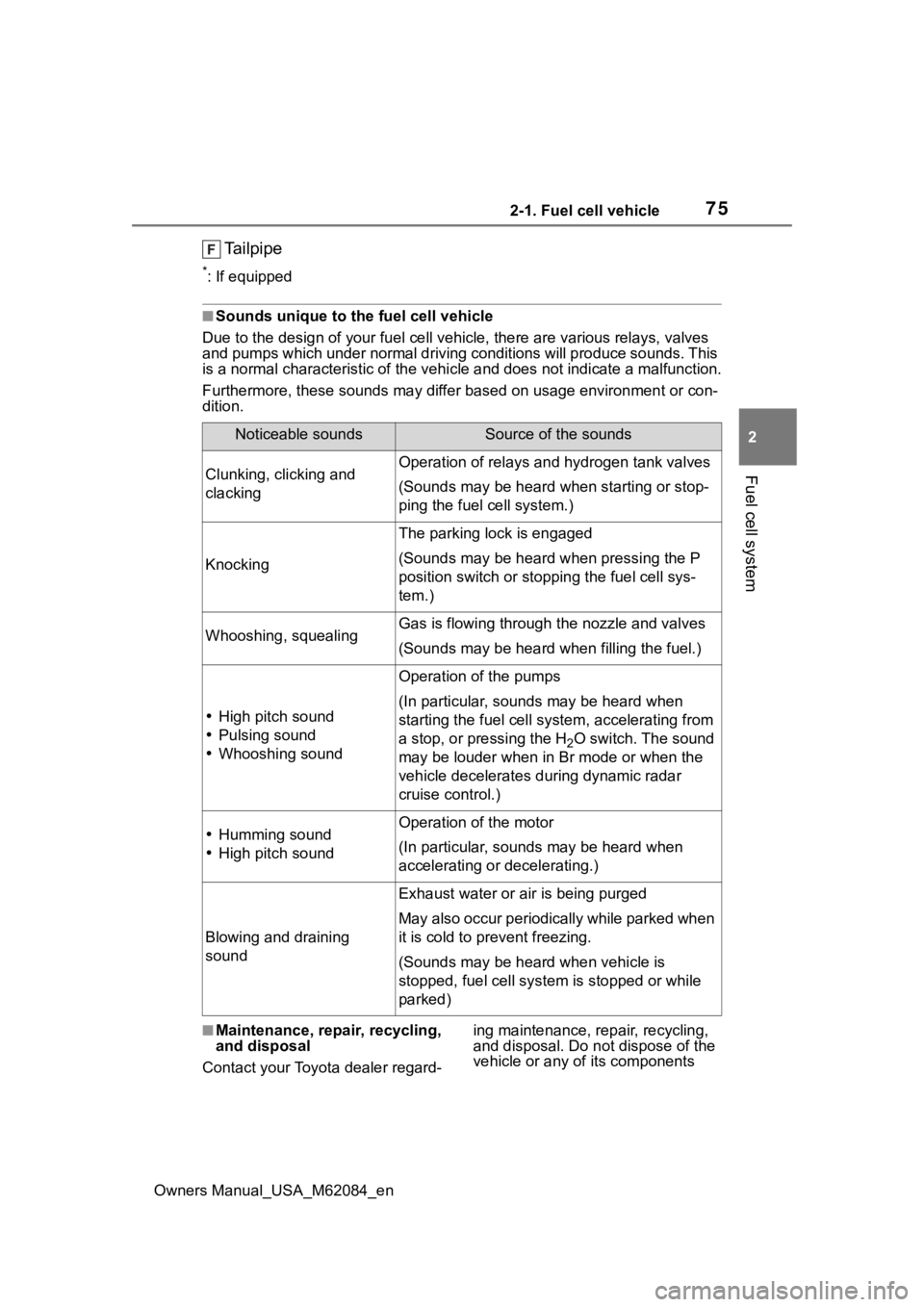
752-1. Fuel cell vehicle
Owners Manual_USA_M62084_en
2
Fuel cell system
Tailpipe
*: If equipped
■Sounds unique to the fuel cell vehicle
Due to the design of y our fuel cell vehicle, there are various relays, valves
and pumps which under normal driving conditions will produce so unds. This
is a normal characteristic of th e vehicle and does not indicate a malfunction.
Furthermore, these sounds may differ based on usage environment or con-
dition.
■Maintenance, repair, recycling,
and disposal
Contact your Toyota dealer regard- ing maintenance, repair, recycling,
and disposal. Do n
ot dispose of the
vehicle or any of its components
Noticeable soundsSource of the sounds
Clunking, clicking and
clackingOperation of relays and hydrogen tank valves
(Sounds may be heard wh en starting or stop-
ping the fuel cell system.)
Knocking
The parking lock is engaged
(Sounds may be heard when pressing the P
position switch or stopp ing the fuel cell sys-
tem.)
Whooshing, squealingGas is flowing through the nozzle and valves
(Sounds may be heard when filling the fuel.)
High pitch sound
Pulsing sound
Whooshing sound
Operation of the pumps
(In particular, sounds may be heard when
starting the fuel cell s ystem, accelerating from
a stop, or pressing the H
2O switch. The sound
may be louder when in Br mode or when the
vehicle decelerates during dynamic radar
cruise control.)
Humming sound
High pitch soundOperation of the motor
(In particular, sounds may be heard when
accelerating or decelerating.)
Blowing and draining
sound
Exhaust water or air is being purged
May also occur periodically while parked when
it is cold to p revent freezing.
(Sounds may be hear d when vehicle is
stopped, fuel cell system is stopped or while
parked)
Page 80 of 556
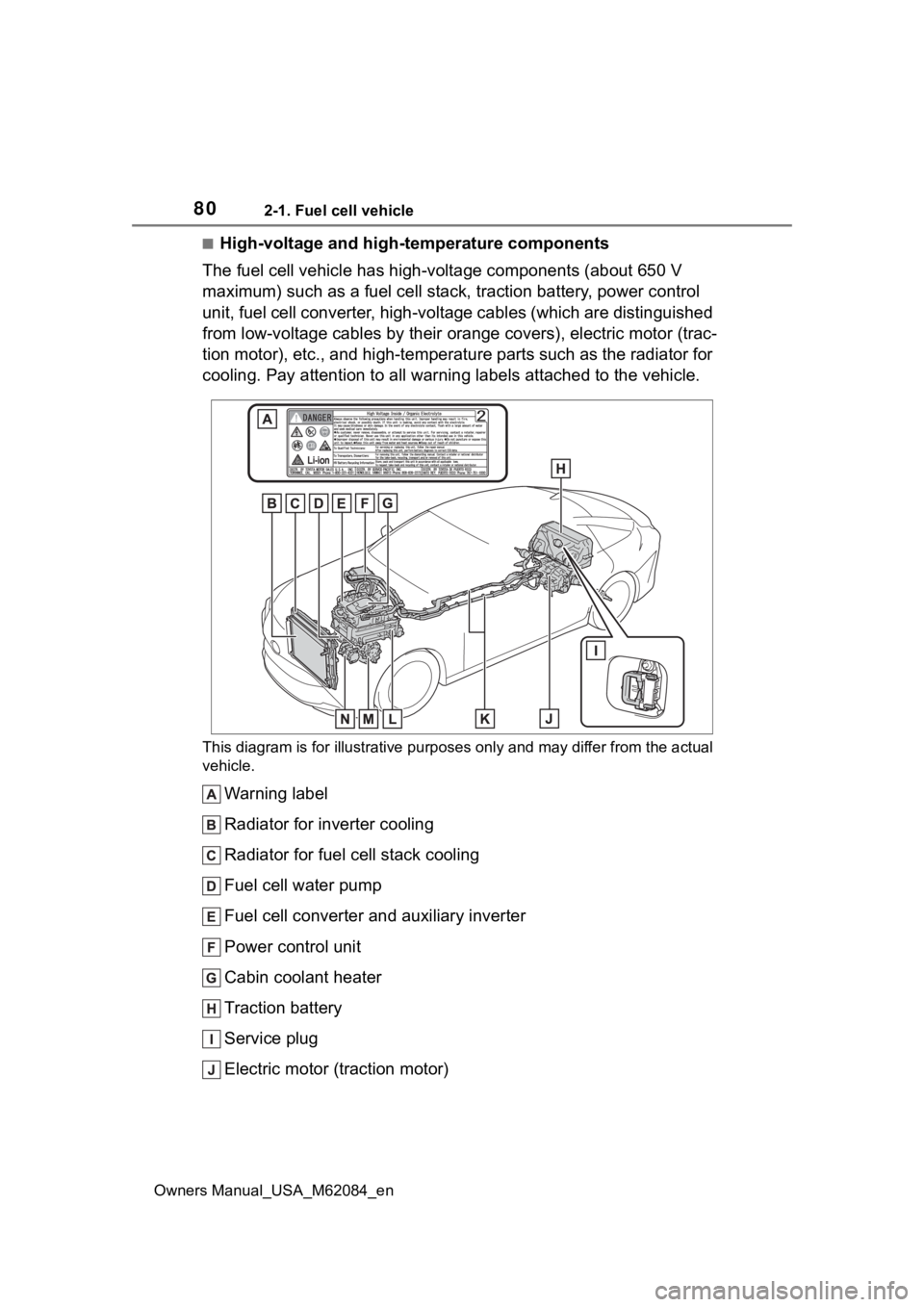
802-1. Fuel cell vehicle
Owners Manual_USA_M62084_en
■High-voltage and high-temperature components
The fuel cell vehicle has high-voltage components (about 650 V
maximum) such as a fuel cell stack, traction battery, power con trol
unit, fuel cell converter, high-voltage cables (which are distinguished
from low-voltage cables by their orange covers), electric motor (trac-
tion motor), etc., and high-temperature parts such as the radiator for
cooling. Pay attention to all w arning labels attached to the vehicle.
This diagram is for illustrative purposes only and may differ f rom the actual
vehicle.
Warning label
Radiator for inverter cooling
Radiator for fuel cell stack cooling
Fuel cell water pump
Fuel cell converter and auxiliary inverter
Power control unit
Cabin coolant heater
Traction battery
Service plug
Electric motor (traction motor)
Page 81 of 556
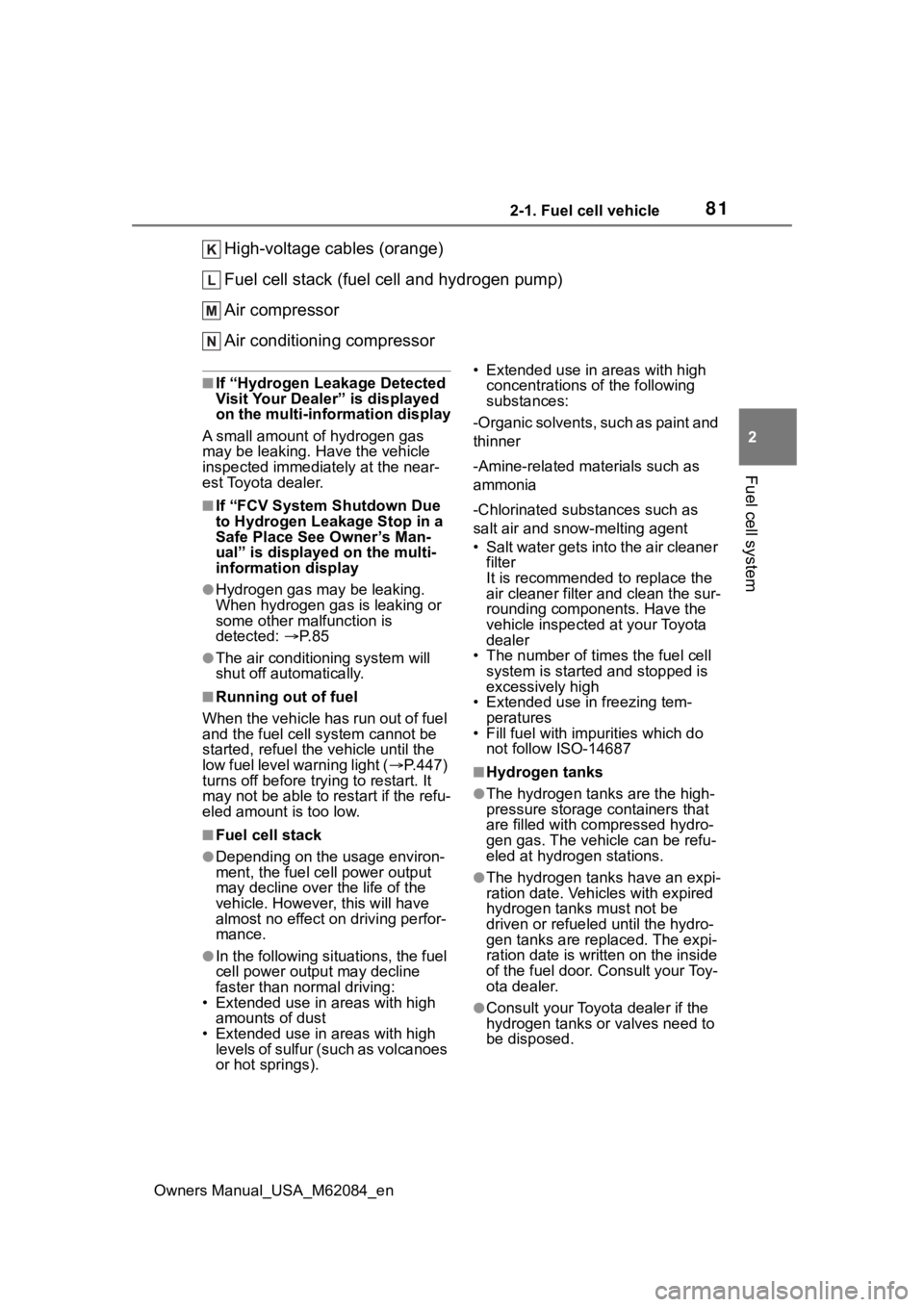
812-1. Fuel cell vehicle
Owners Manual_USA_M62084_en
2
Fuel cell system
High-voltage cables (orange)
Fuel cell stack (fuel cell and hydrogen pump)
Air compressor
Air conditioning compressor
■If “Hydrogen Leakage Detected
Visit Your Dealer” is displayed
on the multi-information display
A small amount of hydrogen gas
may be leaking. Have the vehicle
inspected immediately at the near-
est Toyota dealer.
■If “FCV System Shutdown Due
to Hydrogen Leakage Stop in a
Safe Place See Owner’s Man-
ual” is displayed on the multi-
information display
●Hydrogen gas may be leaking.
When hydrogen gas is leaking or
some other malfunction is
detected: P. 8 5
●The air conditioning system will
shut off automatically.
■Running out of fuel
When the vehicle has run out of fuel
and the fuel cell system cannot be
started, refuel the vehicle until the
low fuel level warning light ( P.447)
turns off before try ing to restart. It
may not be able to restart if the refu-
eled amount is too low.
■Fuel cell stack
●Depending on the usage environ-
ment, the fuel ce ll power output
may decline over the life of the
vehicle. However, this will have
almost no effect on driving perfor-
mance.
●In the following situations, the fuel
cell power output may decline
faster than normal driving:
• Extended use in areas with high amounts of dust
• Extended use in areas with high levels of sulfur (such as volcanoes
or hot springs). • Extended use in areas with high
concentrations o f the following
substances:
-Organic solvents, such as paint and
thinner
-Amine-related materials such as
ammonia
-Chlorinated substances such as
salt air and snow-melting agent
• Salt water gets into the air cleaner filter
It is recommended to replace the
air cleaner filter and clean the sur-
rounding components. Have the
vehicle inspected at your Toyota
dealer
• The number of times the fuel cell system is started and stopped is
excessively high
• Extended use in freezing tem- peratures
• Fill fuel with impurities which do not follow ISO-14687
■Hydrogen tanks
●The hydrogen tanks are the high-
pressure storage containers that
are filled with co mpressed hydro-
gen gas. The vehicle can be refu-
eled at hydrogen stations.
●The hydrogen tanks have an expi-
ration date. Vehicles with expired
hydrogen tanks must not be
driven or refueled until the hydro-
gen tanks are replaced. The expi-
ration date is written on the inside
of the fuel door. Consult your Toy-
ota dealer.
●Consult your Toyota dealer if the
hydrogen tanks or valves need to
be disposed.
Page 200 of 556
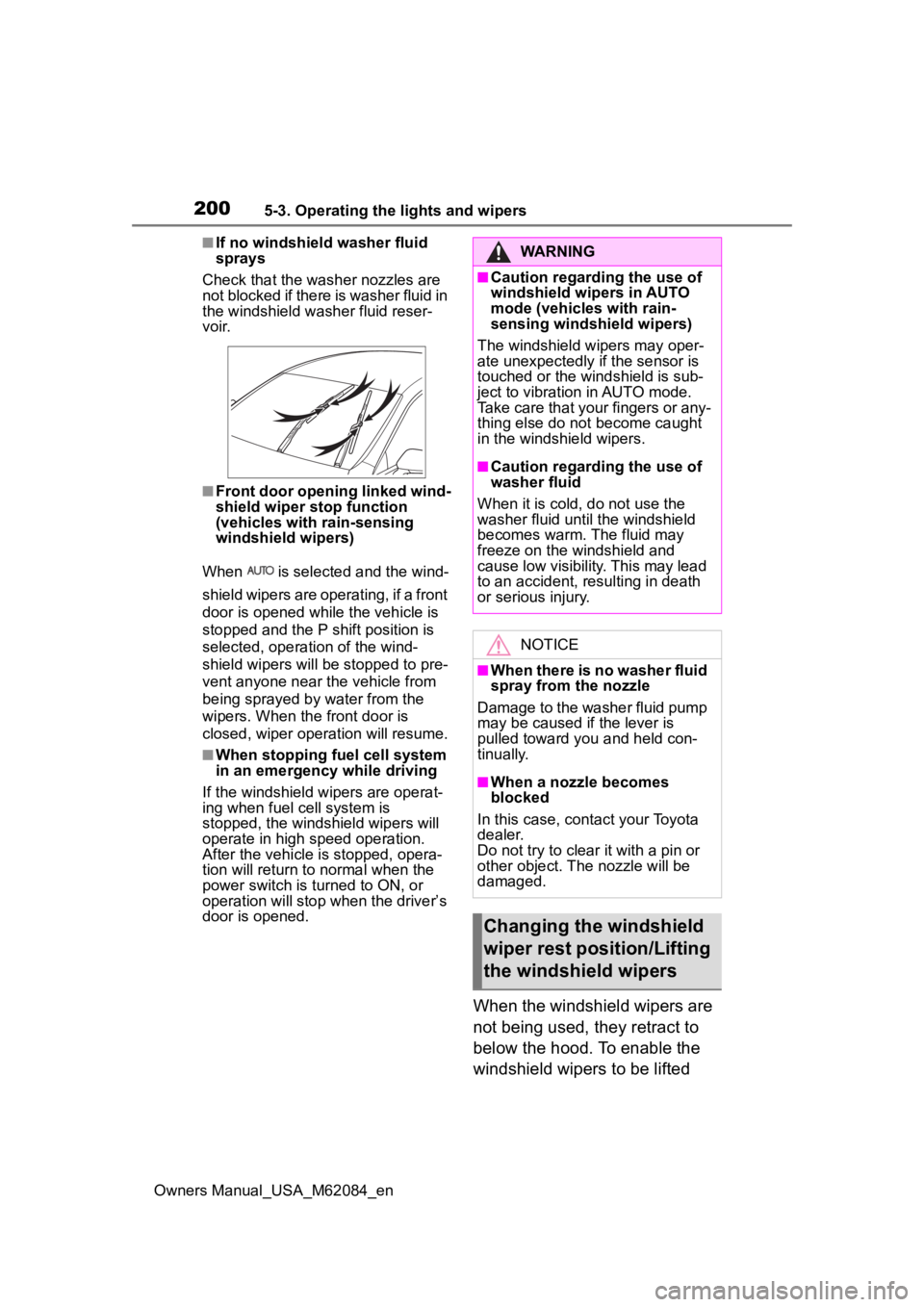
2005-3. Operating the lights and wipers
Owners Manual_USA_M62084_en
■If no windshield washer fluid
sprays
Check that the wash er nozzles are
not blocked if there is washer fluid in
the windshield washer fluid reser-
v oi r.
■Front door opening linked wind-
shield wiper stop function
(vehicles with rain-sensing
windshield wipers)
When is selected and the wind-
shield wipers are operating, if a front
door is opened while the vehicle is
stopped and the P shift position is
selected, operation of the wind-
shield wipers will be stopped to pre-
vent anyone near the vehicle from
being sprayed by water from the
wipers. When the front door is
closed, wiper operation will resume.
■When stopping fuel cell system
in an emergency while driving
If the windshield wipers are operat-
ing when fuel cell system is
stopped, the windshield wipers will
operate in high speed operation.
After the vehicle is stopped, opera-
tion will return to normal when the
power switch is turned to ON, or
operation will stop w hen the driver’s
door is opened.
When the windshield wipers are
not being used, they retract to
below the hood. To enable the
windshield wipers to be lifted
WARNING
■Caution regarding the use of
windshield wipers in AUTO
mode (vehicles with rain-
sensing windshield wipers)
The windshield wipers may oper-
ate unexpectedly if the sensor is
touched or the windshield is sub-
ject to vibration in AUTO mode.
Take care that your fingers or any-
thing else do not become caught
in the windshield wipers.
■Caution regarding the use of
washer fluid
When it is cold, do not use the
washer fluid unt il the windshield
becomes warm. The fluid may
freeze on the windshield and
cause low visibility. This may lead
to an accident, resulting in death
or serious injury.
NOTICE
■When there is no washer fluid
spray from the nozzle
Damage to the washer fluid pump
may be caused if the lever is
pulled toward you and held con-
tinually.
■When a nozzle becomes
blocked
In this case, contact your Toyota
dealer.
Do not try to clear it with a pin or
other object. The nozzle will be
damaged.
Changing the windshield
wiper rest position/Lifting
the windshield wipers
Page 398 of 556
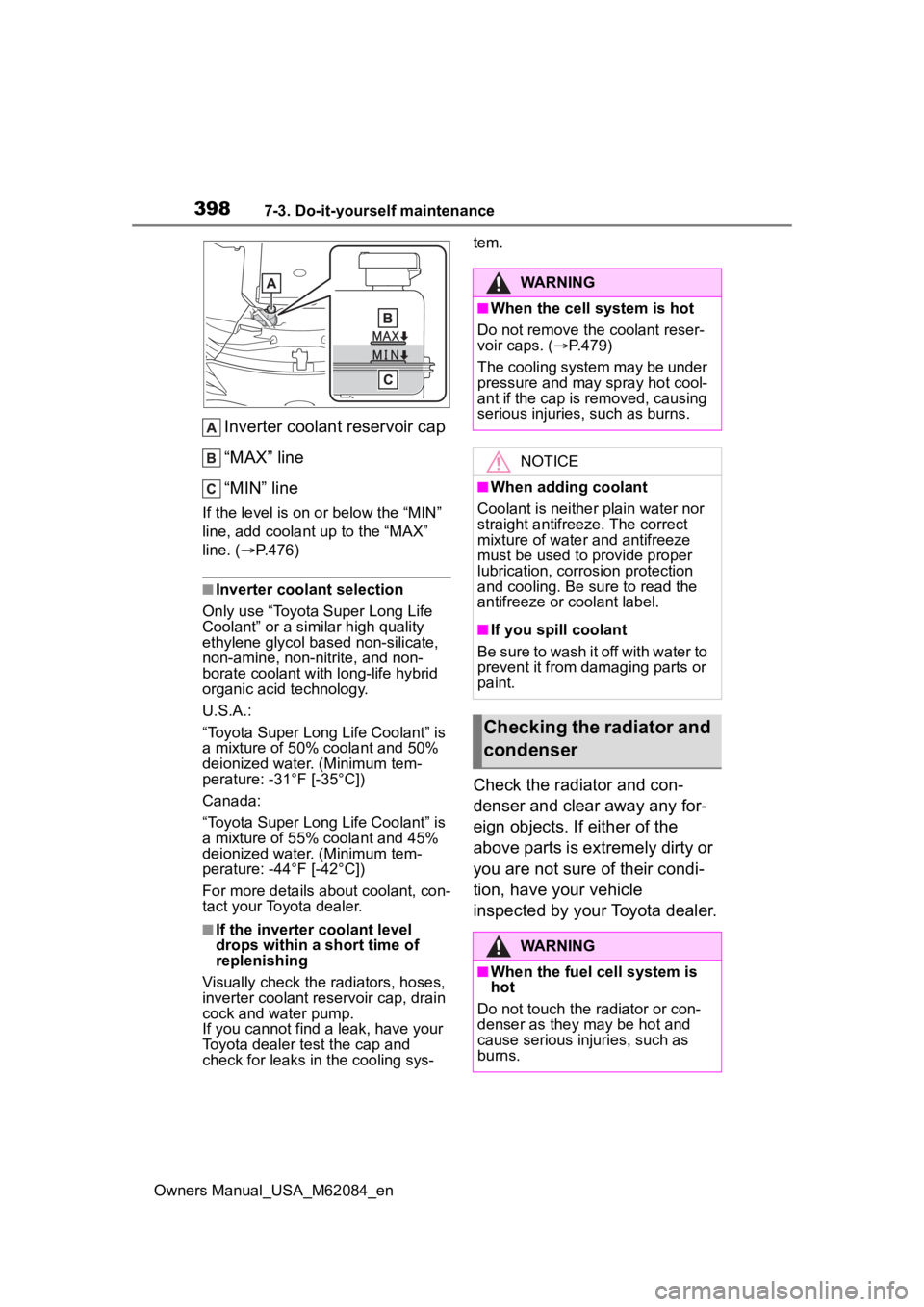
3987-3. Do-it-yourself maintenance
Owners Manual_USA_M62084_en
Inverter coolant reservoir cap
“MAX” line
“MIN” line
If the level is on or below the “MIN”
line, add coolant up to the “MAX”
line. (P.476)
■Inverter coolant selection
Only use “Toyota Super Long Life
Coolant” or a similar high quality
ethylene glycol based non-silicate,
non-amine, non-nitrite, and non-
borate coolant with long-life hybrid
organic acid technology.
U.S.A.:
“Toyota Super Long Life Coolant” is
a mixture of 50% coolant and 50%
deionized water. (Minimum tem-
perature: -31°F [-35°C])
Canada:
“Toyota Super Long Life Coolant” is
a mixture of 55% coolant and 45%
deionized water. (Minimum tem-
perature: -44°F [-42°C])
For more details about coolant, con-
tact your Toyota dealer.
■If the inverter coolant level
drops within a short time of
replenishing
Visually check the radiators, hoses,
inverter coolant reservoir cap, drain
cock and water pump.
If you cannot find a leak, have your
Toyota dealer test the cap and
check for leaks in the cooling sys- tem.
Check the radiator and con-
denser and clear away any for-
eign objects. If either of the
above parts is extremely dirty or
you are not sure of their condi-
tion, have your vehicle
inspected by your Toyota dealer.
WARNING
■When the cell system is hot
Do not remove the coolant reser-
voir caps. ( P.479)
The cooling system may be under
pressure and may spray hot cool-
ant if the cap is removed, causing
serious injuries, such as burns.
NOTICE
■When adding coolant
Coolant is neither plain water nor
straight antifreeze. The correct
mixture of water and antifreeze
must be used to provide proper
lubrication, corrosion protection
and cooling. Be sure to read the
antifreeze or coolant label.
■If you spill coolant
Be sure to wash it off with water to
prevent it from damaging parts or
paint.
Checking the radiator and
condenser
WARNING
■When the fuel cell system is
hot
Do not touch the radiator or con-
denser as they may be hot and
cause serious injuries, such as
burns.
Page 400 of 556
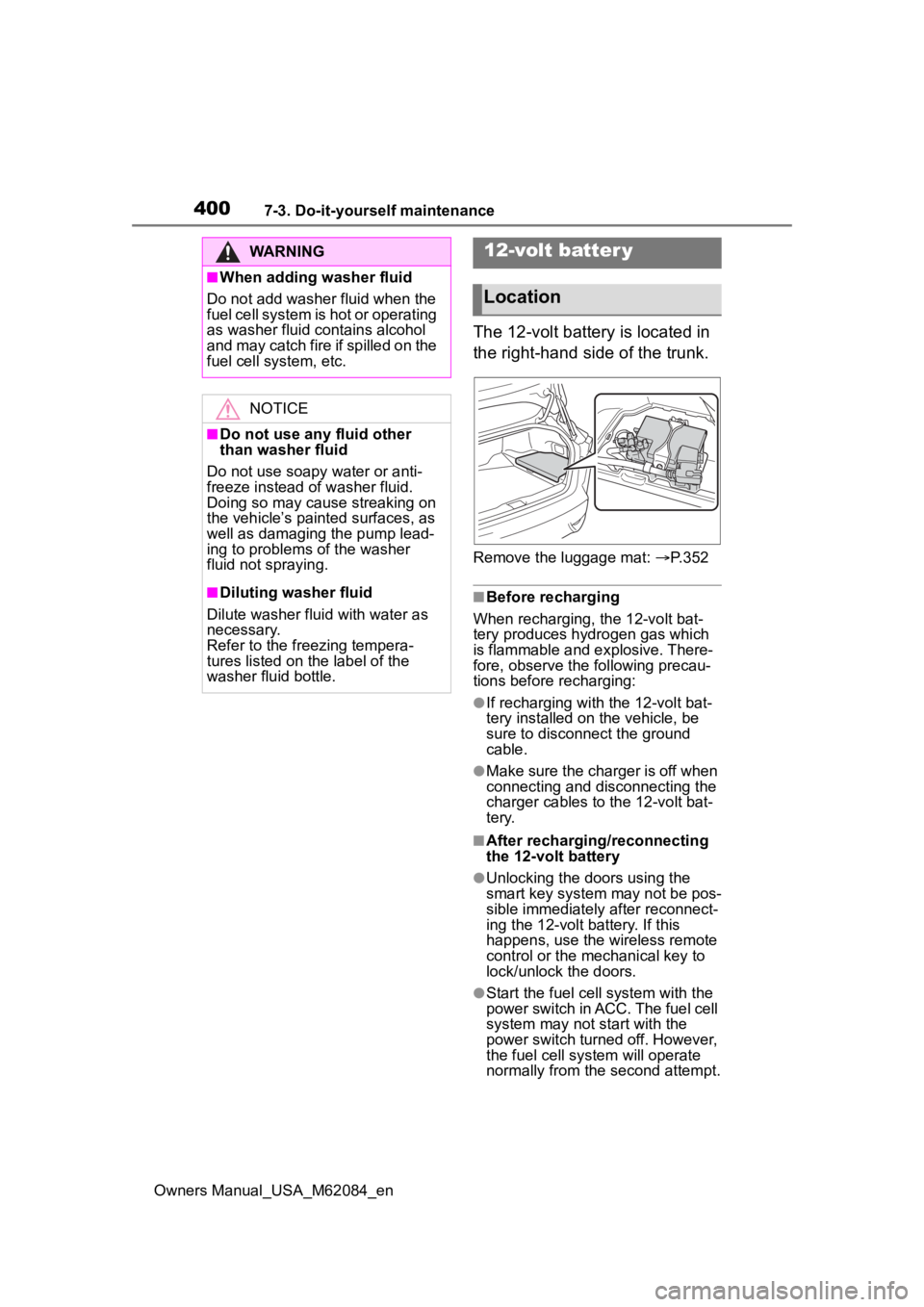
4007-3. Do-it-yourself maintenance
Owners Manual_USA_M62084_en
The 12-volt battery is located in
the right-hand side of the trunk.
Remove the luggage mat: P. 3 5 2
■Before recharging
When recharging, the 12-volt bat-
tery produces hydrogen gas which
is flammable and explosive. There-
fore, observe the following precau-
tions before recharging:
●If recharging with the 12-volt bat-
tery installed on the vehicle, be
sure to disconnect the ground
cable.
●Make sure the charger is off when
connecting and disconnecting the
charger cables to the 12-volt bat-
tery.
■After recharging/reconnecting
the 12-volt battery
●Unlocking the doors using the
smart key system may not be pos-
sible immediately after reconnect-
ing the 12-volt battery. If this
happens, use the wireless remote
control or the mechanical key to
lock/unlock the doors.
●Start the fuel cell system with the
power switch in ACC. The fuel cell
system may not start with the
power switch turned off. However,
the fuel cell system will operate
normally from the second attempt.
WARNING
■When adding washer fluid
Do not add washer fluid when the
fuel cell system is hot or operating
as washer fluid contains alcohol
and may catch fire if spilled on the
fuel cell system, etc.
NOTICE
■Do not use any fluid other
than washer fluid
Do not use soapy water or anti-
freeze instead of washer fluid.
Doing so may cause streaking on
the vehicle’s painted surfaces, as
well as damaging the pump lead-
ing to problems of the washer
fluid not spraying.
■Diluting washer fluid
Dilute washer fluid with water as
necessary.
Refer to the freezing tempera-
tures listed on the label of the
washer fluid bottle.
12-volt batter y
Location